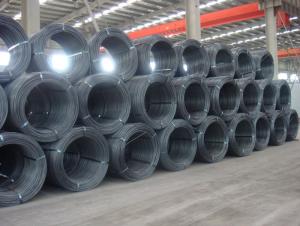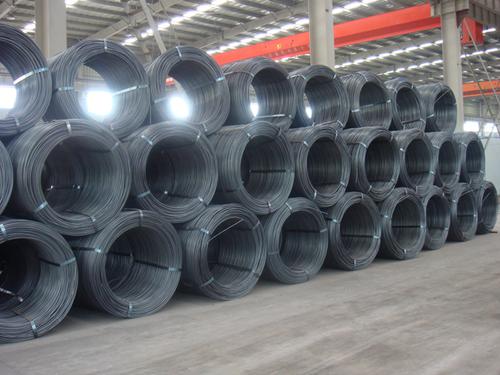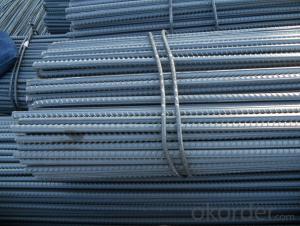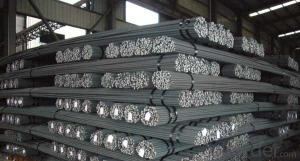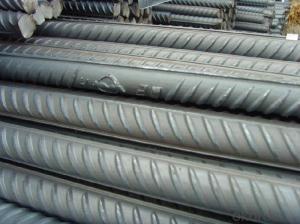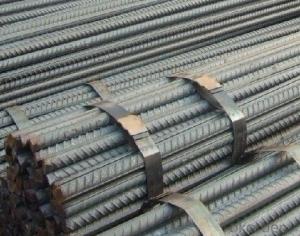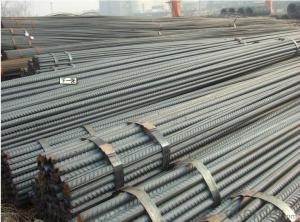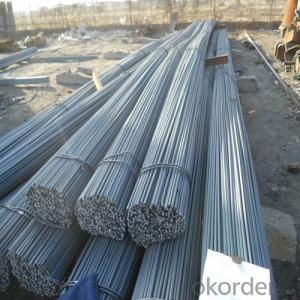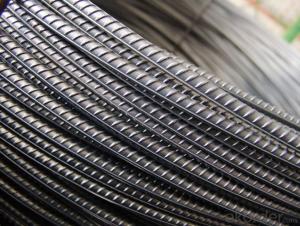Deformed Steel Bar In Coil CRB600H
- Loading Port:
- China Main Port
- Payment Terms:
- TT OR LC
- Min Order Qty:
- -
- Supply Capability:
- -
OKorder Service Pledge
OKorder Financial Service
You Might Also Like
Usage and Applications of HRB400 Deformed Steel Bar:
Deformed bar is widely used in buildings, bridges, roads and other engineering construction. Big to highways, railways, bridges, culverts, tunnels, public facilities such as flood control, dam, small to housing construction, beam, column, wall and the foundation of the plate, deformed bar is an integral structure material. With the development of world economy and the vigorous development of infrastructure construction, real estate, the demand for deformed bar will be larger and larger..
Packaging & Delivery of HRB400 Deformed Steel Bar:
Packaging Detail: products are packed in bundle and then shipped by container or bulk vessel, deformed bar is usually naked strapping delivery, when storing, please pay attention to moisture proof. The performance of rust will produce adverse effect.
Each bundle weight: 2-3MT, or as required
Payment term: TT or L/C
Delivery Detail: within 45 days after received advanced payment or LC.
Label: to be specified by customer, generally, each bundle has 1-2 labels
Trade terms: FOB, CFR, CIF
Deformed Steel Bar in container
- Q: Which is more expensive, rebar or round steel? Which is your business opportunity, such as thread steel and round bar?
- Prices have been rising, customers have expressed that the purchase price increases, we will increase the cost of procurement, coupled with the pressure of funds, so we can not easily buy at the last minute.
- Q: Do l 8, three grade steel have discs?
- Yes, but because of the higher grade of the three screw thread, they are straight bars. It's not necessary to use grade three for 8 mm.
- Q: How do steel rebars affect the overall structural integrity of a building?
- Steel rebars play a crucial role in enhancing the overall structural integrity of a building. They provide reinforcement and strength to the concrete, making it more durable and resistant to various external forces. Firstly, steel rebars act as tension members in reinforced concrete structures. Concrete itself is strong in compression but weak in tension. By embedding steel rebars within the concrete, the composite material is able to withstand tensile forces without cracking or failing. This ensures that the building can withstand the tensile stresses induced by factors such as wind load, seismic activity, and ground settlement. Moreover, steel rebars help to distribute and dissipate loads evenly throughout the structure. They enhance the load-bearing capacity of the concrete, allowing it to withstand heavier loads and prevent the formation of cracks. The rebars also help to control the propagation of any cracks that may occur due to shrinkage or thermal expansion, thereby preventing catastrophic failure. In addition, steel rebars improve the ductility of the reinforced concrete structure. Ductility refers to the ability of a material to deform under stress before reaching its breaking point. By adding steel rebars, the concrete gains the ability to bend and stretch without losing its strength. This is particularly important in areas prone to earthquakes, as the building can absorb and dissipate the energy generated by seismic forces. Furthermore, steel rebars increase the durability and longevity of the building. They provide protection to the concrete by preventing corrosion and degradation. When properly coated and installed, rebars act as a barrier against moisture and other corrosive elements, thereby preserving the structural integrity of the building over time. In conclusion, steel rebars significantly impact the overall structural integrity of a building. They reinforce the concrete, enhance its load-bearing capacity, improve ductility, and increase durability. Incorporating steel rebars into construction ensures that the building can withstand various external forces and maintain its stability and safety for a prolonged period.
- Q: What are the different types of coating for steel rebars?
- There are several different types of coatings that can be applied to steel rebars, including epoxy, zinc, and galvanized coatings. Epoxy coatings provide a protective barrier against corrosion and can be applied as a liquid or powder. Zinc coatings, such as hot-dip galvanizing, involve immersing the steel rebar in molten zinc, forming a durable protective layer. Galvanized coatings involve a similar process but typically use a thinner layer of zinc. These coatings help to extend the lifespan of the steel rebar and prevent corrosion.
- Q: How do steel rebars affect the overall weight of a structure?
- Steel rebars increase the overall weight of a structure due to their high density and strength. Their inclusion in concrete or other building materials provides additional reinforcement, enhancing the structural integrity and load-bearing capacity but also adding to the weight of the structure.
- Q: How do steel rebars prevent cracking in concrete?
- Steel rebars prevent cracking in concrete by providing reinforcement and increasing the overall strength and durability of the structure. When concrete is subject to tensile forces, such as bending or stretching, it tends to crack. However, steel rebars are added to concrete construction to counteract these tensile forces. The rebars, which are made of high-strength steel, are strategically placed within the concrete to create a reinforcing mesh or framework. This mesh acts as a skeleton that absorbs and distributes the tensile forces throughout the concrete structure, preventing the formation of cracks. When external loads, such as heavy weights or seismic forces, are applied to the concrete, the rebars bear the tensile stress instead of the concrete. The steel rebars have a significantly higher tensile strength compared to concrete, allowing them to resist the forces that would normally cause cracking. By distributing the stress more evenly, the rebars minimize the formation of cracks and help maintain the structural integrity of the concrete. Furthermore, steel rebars also prevent cracks by improving the bond between the concrete and the reinforcement. Concrete has excellent compressive strength, but its tensile strength is relatively low. The presence of rebars increases the overall tensile strength of the concrete, making it less likely to crack under tension. The rebars create a bond with the concrete, forming a composite material that can withstand both compressive and tensile forces more effectively. In summary, steel rebars prevent cracking in concrete by providing reinforcement, absorbing tensile forces, and improving the overall strength and durability of the structure. They act as a skeleton within the concrete, distributing stress and preventing the formation of cracks, thereby ensuring the longevity and stability of the concrete construction.
- Q: What is hot rolled coil? Hot rolled coil relative to thread steel and other steel, is not considered a higher point?
- A hot rolled coil is a flat, flat material that is rolled by a billet at a certain temperature.
- Q: Are steel rebars easy to bend and shape?
- No, steel rebars are not easy to bend and shape as they are typically made of strong and rigid materials designed to provide structural support in construction projects.
- Q: Can steel rebars be used in corrosive chemical environments?
- When steel rebars are used in corrosive chemical environments, their performance and durability may be compromised. Certain chemicals, especially acidic ones or those containing chlorides, can cause corrosion in steel. This corrosion can lead to structural damage and a decrease in load-bearing capacity. To reduce the risk of corrosion, there are several measures that can be taken. One common approach is to apply a protective coating, such as epoxy or zinc, onto the rebars. This creates a barrier between the steel and the corrosive environment. Another option is to use stainless steel rebars or other corrosion-resistant alloys, which offer better resistance against chemical corrosion. To determine the best course of action, it is essential to consider the specific chemicals present in the environment. Consulting with corrosion engineers and experts is recommended. Regular maintenance and inspections are also necessary to promptly identify any signs of corrosion and take corrective action. This ensures the reinforced concrete structures remain structurally sound and safe.
- Q: What is the role of steel rebars in retaining walls?
- The role of steel rebars in retaining walls is to reinforce and strengthen the structure, providing increased stability and resistance to lateral pressure exerted by the soil behind the wall. The rebars help to distribute the load evenly throughout the wall, preventing it from cracking or collapsing under the pressure.
Send your message to us
Deformed Steel Bar In Coil CRB600H
- Loading Port:
- China Main Port
- Payment Terms:
- TT OR LC
- Min Order Qty:
- -
- Supply Capability:
- -
OKorder Service Pledge
OKorder Financial Service
Similar products
Hot products
Hot Searches
Related keywords
